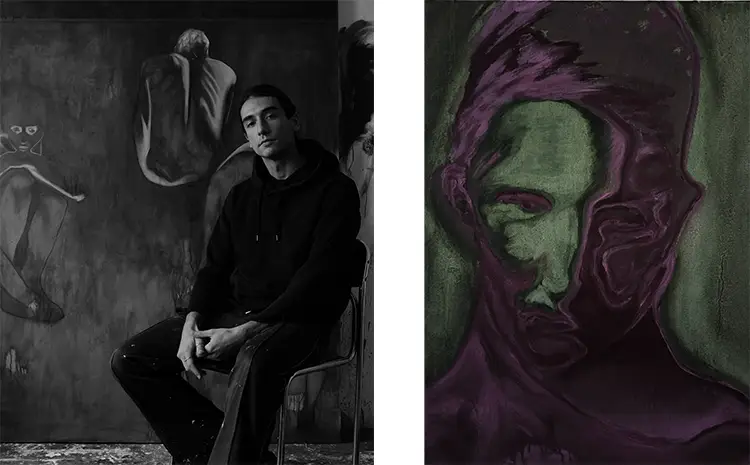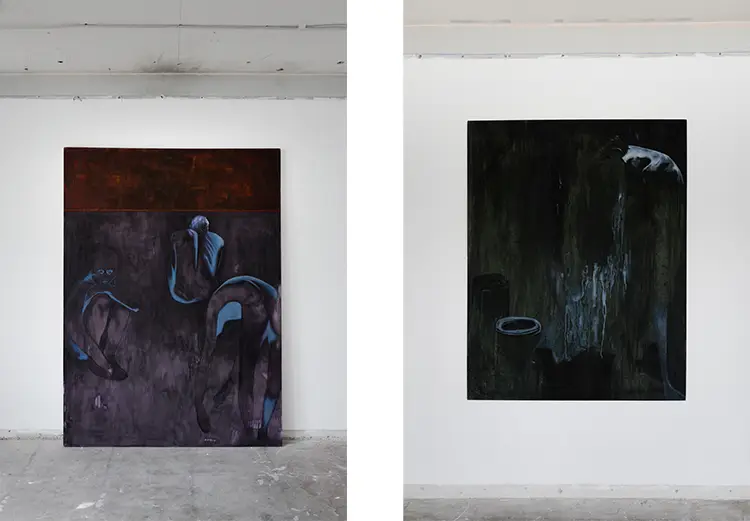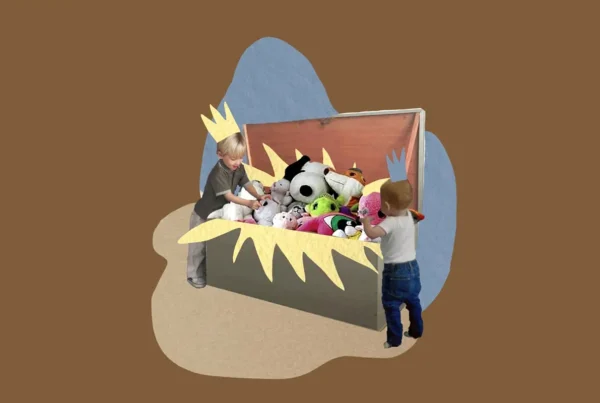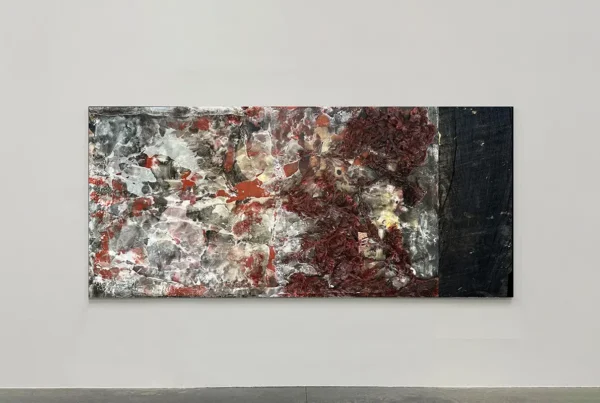“My practice rests on a dual impulse: to mirror the frictions of modernity between living beings and their environments, and, through sustained attention, to reopen the possibility of re-enchantment.”
Shadows of Origin, Sparks of Becoming
Emerging from Fontenay-le-Comte, a town bordered by marshlands and fragmented industry, Ludovic Fleury’s path to art was neither straightforward nor predictable. Born in 1997, he spent his formative years in a landscape where visual culture was largely absent. Only after relocating did he encounter the historical weight and potential of artistic expression. Initially charting a conventional course through economics in Nantes, Fleury eventually moved to Paris, motivated by a deep need to establish a personal visual lexicon. This transition coincided with a health crisis that transformed his understanding of the body—not as a static vessel, but as a conflicted, ever-questioned space. These prolonged medical experiences not only marked his physical existence but continue to saturate his artistic production with a persistent inquiry into fragility, exposure, and corporeal boundaries.
Fleury’s earliest creative aspirations leaned towards manga, with figures like Sui Ishida and Boichi shaping his youthful visions. The kinetic energy and emotional intensity of their drawing styles resonated with him deeply. Later, the underground electronic music scene in Nantes expanded his awareness of multisensory experiences, helping him reimagine what art could be. Paris offered a more complex terrain—unfamiliar, competitive, but also invigorating. With no established connections in the city’s art circles, Fleury began building his practice independently, navigating setbacks and learning through experimentation. Over time, he carved out a presence within a loose but receptive community, refining his voice while resisting any formulaic approach to medium or theme.
His work consistently returns to transitional states—moments of collapse, emergence, and transformation. Fleury’s pieces are grounded in material exploration but never lose sight of philosophical undercurrents. The experience of illness sharpened his attentiveness to the body as both intimate and alien, a perception that underlies even his most abstract gestures. Whether confronting the mechanical sterility of medical environments or engaging with the quiet violence of ecological degradation, Fleury resists definitive interpretations. Instead, he offers viewers a shifting terrain—one where boundaries blur and meaning remains elastic.

Ludovic Fleury: Painting Where the Body Fractures
Fleury’s creative output resists confinement, spanning figurative oil painting, installation, and sporadic forays into performance. His focus lies in spaces of dislocation: anatomical, environmental, and narrative. A signature piece, Trouble de la Chair (2024), embodies this ethos vividly. Comprising paintings, sculptural interventions, and an audio component, it intertwines fragmented human forms with hospital tubes and invasive plant species. Rather than simply portraying distress, the work interrogates it, suggesting that vulnerability may hold disruptive potential. Fleury’s visual syntax—marked by layered oil washes, tactile impasto, and strategic erasures—echoes the unpredictable rhythms of chronic illness, creating surfaces that pulse with ambivalence.
He recently expanded this inquiry through Théâtre du Liminal, a series that situates post-industrial ruins as meeting grounds for human and non-human agents. These pieces move beyond medical imagery to consider broader ecologies of instability. Ruins here are not nostalgic backdrops but active agents, interwoven with organic decay and speculative growth. Influenced by post-phenomenological thinking and ecocritical frameworks, Fleury constructs visual fields where agency is fluid and time is non-linear. Yet despite these intellectual foundations, his method remains rooted in the physical act of painting. Paint behaves as both archive and event—each brushstroke a mark of negotiation.
What distinguishes Fleury’s approach is his sustained engagement with materiality as a vehicle for conceptual rigor. He regards painting not just as a representational tool but as a sensual process that resists closure. The physicality of oil—its capacity for accumulation, revision, and erosion—mirrors his lived experience of recurring pain and partial recovery. Across canvases, one finds signs of strain and serenity coexisting: layered surfaces that shimmer, rupture, and mend. This duality, so central to his life, finds a nuanced articulation in his visual language, inviting viewers to confront their own thresholds of comfort and perception.

The Studio as Shelter and Sensorium
Within the intimacy of his compact Paris studio, Fleury constructs a rhythm uniquely attuned to both his physical condition and creative needs. The space operates as a refuge, a site where painting unfolds not through compulsion but through cycles of attention and withdrawal. He often works on multiple canvases simultaneously, allowing ideas to evolve across surfaces without rigid chronology. Coffee and cigarettes bracket the start of each session, grounding him in familiar rituals before music—ranging from ambient compositions to rap—sets the emotional tempo. The studio becomes an extension of his body’s tempo: when discomfort overwhelms, he steps away to walk, read, or rest, understanding that these pauses are not interruptions but integral parts of making.
This adaptive rhythm has enabled Fleury to deepen his experimentation with media. While oil remains his foundational material, chosen for its slow response and capacity for reversibility, he frequently employs digital tools such as 3-D modeling and collage during the planning phases. When appropriate, he incorporates sound, photography, or other sensory components to activate different registers of perception. Yet, no matter how many disciplines he brushes against, painting retains a privileged position—a space of intimacy and resistance, capable of holding contradiction without collapsing into it.
Among the works that embody this ethos is Chair exposée (2024), a haunting composition in which a human flank is dissected by searing neon light. Previous layers bleed through like subsurface tissue, creating a tension between painterly depth and clinical detachment. The piece evokes not just bodily vulnerability but the psychological toll of medical scrutiny. Another emotionally charged painting, Aponia (2024), was conceived during a prolonged flare-up. Featuring a dissolving figure amidst a field that could be either bed or earth, and poppies that nod to both childhood and narcotic relief, it oscillates between gentleness and unease. To Fleury, the work hums with barely suppressed feedback—a visual metaphor for the violence that often accompanies attempts at calm.

Ludovic Fleury: Toward Collective Embodiment
Fleury’s ambition reaches beyond the canvas. One of his most urgent desires is to stage Trouble de la Chair as a fully immersive project, combining painting with sculptural forms, soundscapes, and a choreographed performance. Such an endeavor would bridge solitary studio practice with shared public experience, transforming private pain into a communal encounter. The idea is not to aestheticize suffering but to make visible the lived experience of chronic illness in all its contradictions. Through movement, sound, and image, Fleury aims to challenge the sterile detachment often associated with clinical spaces and invite viewers into a sensorial, embodied exchange.
His fascination with scale reflects a related interest in the physical demands of painting. Working on large-format canvases enables him to approach painting as an embodied gesture rather than a cerebral exercise. Broad strokes, sweeping gestures, and bodily proximity to the surface create an immediacy that smaller works often constrain. He sees scale not as spectacle but as an opportunity for more visceral contact—between artist, artwork, and audience. This physical intensity mirrors his overarching interest in negotiation: between flesh and architecture, silence and sound, collapse and continuation.
Fleury’s influences underscore the breadth of his thinking. Francis Bacon’s capacity to suspend the viewer in a moment of visual rupture, Miriam Cahn’s fearless engagement with political and formal breakdown, and Mark Rothko’s chromatic resonances all resonate in his work. Beyond painting, the speculative anatomies of David Cronenberg’s cinema and the explosive physicality of Hofesh Shechter’s choreography inform his sense of spatial tension and affective charge. Each of these references finds a distinct echo in Fleury’s practice, yet none define it. What unites them is their willingness to confront uncertainty—an ethos that lies at the heart of everything Fleury creates.






